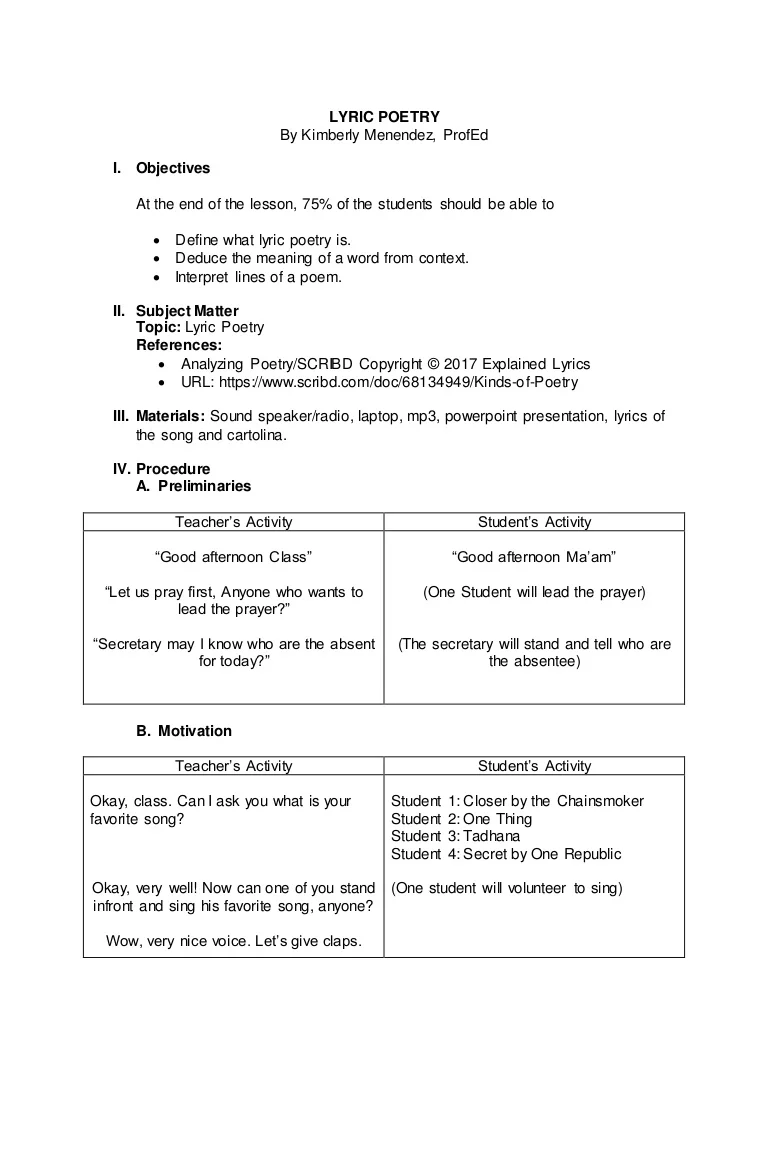
Lesson Plan Teaching Poem
The Lesson Plan Teaching Poem is a unique form of poetry that combines the elements of a lesson plan with the creativity of a poem. It is a powerful tool for educators and students alike, providing a way to engage with learning in a meaningful and memorable way.
Characteristics of a Lesson Plan Teaching Poem:
- Follows the structure of a lesson plan, including objectives, materials, activities, and assessment
- Uses poetic devices such as rhythm, rhyme, and metaphor to enhance learning
- Engages students through vivid imagery, storytelling, and personal experiences
- Fosters critical thinking, problem-solving, and creativity
Writing Styles Suitable for Lesson Plan Teaching Poems:
- Free Verse: No特定韵律or meter,allows for flexibility and expression
- Rhyming Couplets: Creates a sense of rhythm and flow, making poems easy to remember
- Haiku: A traditional Japanese form with three lines of 5, 7, and 5 syllables
- Sonnet: A 14-line poem with a specific rhyme scheme and meter
- Lyric Poetry: Expresses personal emotions and experiences, suitable for reflecting on teaching moments
Poems about Lesson Plan Teaching Poem:
Ode to the Lesson Plan
Oh, lesson plan, my faithful guide,
You chart the course with steady stride.
Your objectives, clear and bright,
A beacon leading through the night.
The Symphony of Learning
Like instruments in an orchestra’s embrace,
Materials dance, each adding grace.
Activities intertwine in harmony,
A symphony of learning, vibrant and free.
The Assessment’s Dance
Assessment’s touch, a delicate art,
Measuring progress, playing its part.
It steps with grace, a guiding hand,
Informing choices, mapping the land.
Tips for Writing Lesson Plan Teaching Poems:
- Start with a strong hook: Begin with a captivating image, anecdote, or question.
- Use vivid language: Paint a picture with words, using sensory details and metaphors.
- Incorporate humor: A touch of humor can make learning more enjoyable.
- Keep it concise: A lesson plan poem should be brief and focused.
- Get feedback: Share your poem with others and seek their input.
How to Read a Lesson Plan Teaching Poem:
- Analyze the structure: Note how the poem follows the lesson plan format.
- Identify the poetic devices: Pay attention to rhythm, rhyme, and other literary techniques.
- Listen to the voice: Consider the perspective and tone of the poem.
- Draw connections: Link the poem’s themes to your own teaching experiences.
- Reflect on the learning: Use the poem as a starting point for reflection and discussion.
FAQs:
- What are the benefits of using Lesson Plan Teaching Poems? They engage students, foster creativity, and provide a memorable way to learn.
- Can anyone write a Lesson Plan Teaching Poem? Yes, with practice and inspiration, educators of all levels can create effective poems.
- How can I share my Lesson Plan Teaching Poems? Publish them in educational journals, share them with colleagues, or post them on online platforms.
Conclusion:
The Lesson Plan Teaching Poem is a versatile and transformative genre that empowers educators and students to connect with learning on a deeper level. By embracing poetic techniques, we can create engaging and unforgettable experiences that nurture creativity and ignite a passion for knowledge.
Remember, plagiarism is a serious offense. Always give credit to the original author and share your work with others to inspire and connect with the global community of educators. Thank you for reading, and may your lessons dance with the rhythm of poetry!
